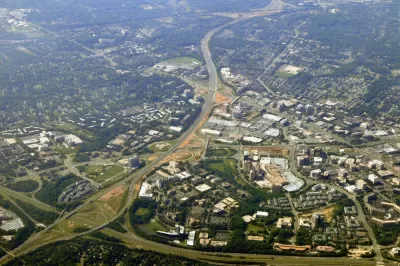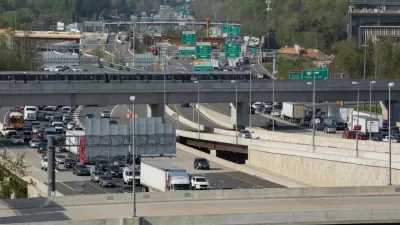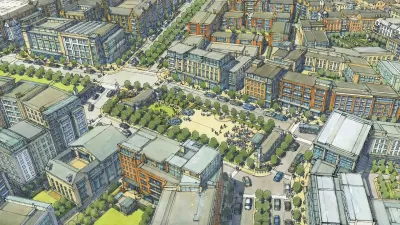A 2010 comprehensive plan set a goal to add 100,000 residential units with walkable access to public transit to this unincorporated corner of Fairfax County in Northern Virginia.

Emily Hamilton checks in with the "years-long effort to redevelop the land surrounding the four Tysons Metro stations that opened in 2014" in Northern Virginia.
A mixed-use development called The Boro, is one of the recent developments designed to improve the walkability of the formerly office-oriented area. The Boro is located in Tysons near the Greensboro Metro Station, with 667 apartments and condos so far, as well as high-end retail, one of the nation’s largest Whole Foods, and new office buildings, according to Hamilton.
Plans for Tysons, documented in a 2010 comprehensive plan approved by Fairfax County, call for much more, reports Hamilton.
The new housing at the Boro is just a fraction of the new buildings that have been delivered and that are in the planning stages for the Tysons. The Boro — with safe, shaded streets and a healthy mix of housing, office, and retail development — is an example of the type of development that the Tysons planning documents call for.
Tysons is shooting for a residential population of 100,000 by the year 2050, but despite the obvious progress already made toward that goal, Tysons has a long way to go. Hamilton explains:
As of the latest Progress Report on Tysons, 12,991 homes were in Tysons—about 4,000 of them delivered since 2011. There were nearly an additional 1,000 units under construction, and about 30,000 more were either approved or under review. New housing construction has taken time to ramp up in response to the major upzoning; so far fewer than 1,000 units have been delivered per year, not on pace to reach housing for 100,000 residents by 2050.
The article includes evidence that the quick pace of construction is improving affordability in the area, as well as an evaluation of the changing walkability of Tysons as a result of all the development. Hamilton's conclusion: Tysons has a lot more significant work to do to achieve the goals for walkability laid out in the 2020 comprehensive plan.
FULL STORY: Tysons housing permits are ahead of plan, but walkability lags behind

Maui's Vacation Rental Debate Turns Ugly
Verbal attacks, misinformation campaigns and fistfights plague a high-stakes debate to convert thousands of vacation rentals into long-term housing.

Planetizen Federal Action Tracker
A weekly monitor of how Trump’s orders and actions are impacting planners and planning in America.

In Urban Planning, AI Prompting Could be the New Design Thinking
Creativity has long been key to great urban design. What if we see AI as our new creative partner?

Pedestrian Deaths Drop, Remain Twice as High as in 2009
Fatalities declined by 4 percent in 2024, but the U.S. is still nowhere close to ‘Vision Zero.’

King County Supportive Housing Program Offers Hope for Unhoused Residents
The county is taking a ‘Housing First’ approach that prioritizes getting people into housing, then offering wraparound supportive services.

Researchers Use AI to Get Clearer Picture of US Housing
Analysts are using artificial intelligence to supercharge their research by allowing them to comb through data faster. Though these AI tools can be error prone, they save time and housing researchers are optimistic about the future.
Urban Design for Planners 1: Software Tools
This six-course series explores essential urban design concepts using open source software and equips planners with the tools they need to participate fully in the urban design process.
Planning for Universal Design
Learn the tools for implementing Universal Design in planning regulations.
planning NEXT
Appalachian Highlands Housing Partners
Mpact (founded as Rail~Volution)
City of Camden Redevelopment Agency
City of Astoria
City of Portland
City of Laramie





























